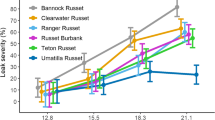Abstract
A study was conducted to determine the feasibility and advantages of wound-healing potatoes at lower than recommended temperatures. The progress of wound-healing at 6, 9, and 16°C, of tissue taken from Russet Burbank potato tubers, was evaluated by inducing weight loss with high temperature or decay organisms following various curing intervals. Increasing the wound-healing temperature resulted in a greater resistance to weight loss and a decreased susceptibility to infection byErwinia carotovora subsp.carotovora. Resistance to weight loss increased as wound-healing temperature increased following 6 and 16 day intervals. However, weight loss induced after 21 days of healing appeared to level off at 9°C indicating maximum development of a wound barrier. Loss due to rot, after inoculation of fresh cores withE. carotovora, was directly proportional to incubation time and temperature. When wound-healing progress was measured by loss of fresh weight induced by elevated temperatures or rot, the advantages of woundhealing at 16°C compared with 9°C decreased significantly after 21 days of curing. Wound-healing at approximately 9°C for 25 days was found to be the best compromise temperature for keeping rot progress and weight loss at a minimum while allowing the process of healing and maturation to occur.
Resumen
Se realizó un estudio para determinar la posibilidad de usar la cicatrizatión de heridas a temperaturas más bajas de las recomendadas. El proceso de cicatrización a 6, 9 y 16°C de tejidos tornados de tubérculos de papa Russet Burbank fue evaluado por medio de la inducción de pérdida de peso con temperatura alta u organismos causantes de descomposición después de varios intervalos de curación. Al aumentar la temperatura de cicatrización obtuvo una mayor resistencia a la pérdida de peso y bajó la susceptibilidad a infectión por Erwinia carotovora subsp. carotovora. La resistencia a pérdida de peso aumentó con el incremento de temperatura de cicatrización después de intervalos de 6 y 16 dias. Sin embargo, la pérdida de peso inducida después de 21 dias de cicatrization pareció nivelarse a 9°C indicando un desarrollo máximo de una barrera cicatrizada. Las pérdidas acaecidas por pudrición, después de inoculación de cilindros de tejidos frescos con E. carotovora, fue directamente proportional al tiempo de incubación y a temperatura. Cuando el progreso de cicatrizatión fue medido a través de pérdida de peso fresco, inducida por temperaturas altas o pudrición, las ventajas de cicatrization a 16°C compradas con 9°C dismunuyó significativamente después de 21 dias de curación. Las condiciones de temperatura y tiempo que en término medio resultaron mejor para mantener al minimo la pudrición y pérdida de peso mientras se permitian los procesos de cicatrizatión y maduración fueron 9°C y 25 días.
Similar content being viewed by others
Literature Cited
Iritani, W.M. 1968a. Factors affecting physiological aging (degeneration) of potato tubers used as seed. Am Potato J 45:111–116.
—1968b. The effect of storage temperature and source on productivity of Russet Burbank seed. Am Potato J 45:322–326.
Iritani, W.M. and L.D. Weller. 1976. The influence of early storage (pre-holding) temperatures on sugar accumulation in Russet Burbank potatoes. Am Potato J 53:159–167.
Kawakami, K. 1980. Age of potato tubers. Potato Res 23:256.
Kolattukudy, P.E. and B.B. Dean 1974. Structure, gas Chromatographic measurement and function of suberin synthesized by potato tuber slices. Plant Physiol 54:116–121.
Perennec, P. and P. Madec. 1980. The physiological age of seed potatoes; influence on sprouting and effects on the subsequent behavior of the plants. Potato Res 23:196–197.
Sacher, R.F. 1980. Physiological age of potato seed tubers. Ph.D. dissertation, Washington State University.
Smith, Ora. 1968. “Potatoes: Production, Storing, Processing.” The AVI Publishing Co., Inc., Westport, CT. pp. 344–358.
Thornton, R.E. and J.B. Sieczka. 1980. Commercial potato production in North America. Am Potato J Supplement 57:1–36.
Vidaver, A.K. 1967. Synthetic and complex media for the rapid detection of fluorescence of phytopathogenic pseudomonads: Effect of the carbon source. Appl Microbiol 15:1523–1524.
Ware, G.W. and J.P. McCollum. 1975. “Producing Vegetable Crops.” The Interstate Printers and Publishers, Inc., Danville, IL. pp. 403–420.
Author information
Authors and Affiliations
Additional information
Scientific paper No. 6150. College of Agriculture Research Center, Washington State University, Pullman, 99164. Project No. 1949.
Rights and permissions
About this article
Cite this article
Knowles, N.R., Iritani, W.M., Weiler, L.D. et al. Susceptibility of potatoes to bacterial rot and weight loss as a function of wound-healing interval and temperature. American Potato Journal 59, 515–522 (1982). https://doi.org/10.1007/BF02852600
Received:
Issue Date:
DOI: https://doi.org/10.1007/BF02852600




